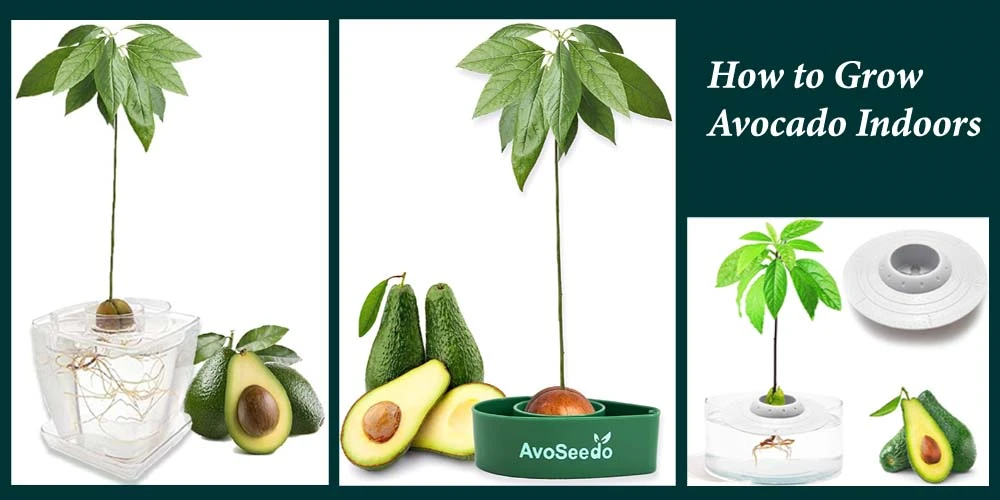reviewed by Truman Perkins
Avocado trees most likely originated in Southern Mexico. The pear-shaped fruits are delicious fruit. A rich source of vitamins and nutrients that make an excellent condiment use in salads. The trees are a preference for tropical to sub-tropical temperature plants. That is why northern gardeners should learn "How to Grow Avocado Indoors" as potted indoor plants to enjoy fruits grown at home.
Growing avocado trees is a fun way to introduce organic fruit to our family. Avocados are medium to large trees but have small varieties that exist for home growing. Nowadays, Avacados are growing indoors by a lot of sophisticated gardeners. The plants are pretty much attractive to see and increase the aesthetic value of your house. Avocado information wouldn't be complete without mentioning the three distinct groups of the fruit from which all cultivars derive. These main varieties are West Indian avocado, Guatemalan avocado, and Mexican avocado.
Contents

You can choose a pit-growing avocado, but it is most successful with a healthy grafted dwarf tree. At first, preserve an avocado pit and wash off the debris or residue. Let insert 3-4 toothpick in the middle of the pit. Then submerged the bottom third of the seed in a drinking jar or glass. Roots and sprouts will appear in about 2-6 weeks. The narrower top of the seed is where the stem and leaves will grow. The broader end of the seed is where the roots will grow.
The pit should dip an inch or so into the water at the dented or dimpled end. Place the glass in bright light where temperatures are at least 65˚ degrees. Change the water frequently. Soon the pit will produce roots, which will grow down into the water. Eventually, stems and leaves will sprout. After six weeks, roots and a stem shoot should begin emerging from the seed. Continue to change the water in the glass and wait until the stem is between six and seven inches long. Cut it back to three inches and wait for it to sprout leaves, then it is time to transplant to a pot.
Following essentials are needed planting avocado.

Growing avocado indoors is enjoyable and easy. Once you have seen roots and healthy-looking leaves, it's time to transplant into a pot. Take a pot ten inches or larger in diameter with suitable drainage holes; terra cotta is an excellent choice for avocados. The most important thing to provide an avocado plant is good drainage. Use sandy potting soil designed as something loose, fertile, and well-drained.
You can find this type of potting soil at most local gardening centers. Some coarse stones placed in the bottom of the pot can ensure good drainage, too. Loosely fill the pot almost to the top with potting mix and make a hole deep enough for the avocado seedling's roots. Spread the roots out and gently pack soil around the pit, leaving the top of the seed above the soil line. Water gently until water runs from the drainage holes, wait for it to stop, and then place the pot into a drainage dish in a south-facing window.
Avocados are sensitive plants with some particular requirements. They do best in warm temperatures, ideally between 60 and 85 degrees Fahrenheit which makes them excellent indoor plants. They enjoy full sun and may benefit from a bit of supplemental light during the winter months.
Avocado trees cannot survive in too much water. Overwatering is one of the significant causes of death for potted avocado trees, so don't overdo it. Always check the moisture level of the soil before watering. This is particularly important in the first year as the tree is getting established. Yellowing leaves are usually a sign of overwatering. If it looks like your avocado tree is yellowing, let it dry out for a few days.
The best method for watering an avocado plant is to do a deep soak once a week or as soon as the leaves show signs of drooping. The best policy is to check in every day with a plant to see how it is doing. Watering in winter can be especially problematic, as the water in the soil evaporates more slowly in cooler months.
Cutting down the plant's branches might feel mercenary, but the truth is it enhances stronger and more robust than single-stemmed growth. In this regard, always use a sharp apparatus to cutting down your branches.
When your avocado seedling reaches twelve inches or so, trim the tip and top leaves off. Take a note that you should cut down just above a growth node. The attempt will ensure healthy seedlings for the future. Once lateral stems are six to eight inches long, trim the new growth at the tips off.
Pruning in this way is only advisable in the first year when the shape of the tree is fixed. After that, only prune once a year in autumn or winter. Once a seedling is over two feet tall, staking it will help to support its weight. A piece of bamboo makes a perfect stake, drives it into the soil near the base of the plant, and ties the stem loosely with a twist-tie or piece of twine.
Spraying copper, zinc, manganese, and boron (trace elements) are critical external nutrients for avocado seedlings. Apply these every couple of months in spring and summer for the first four years. It will help your tree get to the point where it can bear fruit. When your tree begins to set fruit, increase potash fertilization to fifteen percent.
If you notice your avocado tree leaves drooping, check the soil's moisture by inserting your finger, up to the second knuckle, into the soil to determine whether the soil is too wet or too dry. Typically overwatering is the problem, but if the soil is dry, water the plant.
Discard infected soil if there is evidence of fungus. Allow the exposed roots to dry out, which will help kill the fungus. Replace with clean, well-drained potting soil. Applying a powder or granular antifungal treatment to the new soil may also help eliminate the infection. Distribute the antifungal evenly throughout the soil.
When your plant begins to set fruit, it may set a huge number at first. It will most likely drop a large number of these fruits, so don't panic; it's perfectly normal. Once the fruit reaches a mature size, pick one and let it sit on a shelf for a few days because avocados do not ripen on the plant.
When your avocado tree bears fruit, you will have a unique and beautiful houseplant that will impress your guests. However, if you take your time and treat your tree the right way, you will be rewarded with the rarest of homegrown fruits, avocados.
 |
 |
 |
 |

About Truman Perkins
Truman Perkins is a Detroit-based SEO consultant who's been in the business for over a decade. He got his start helping friends and clients get their websites off the ground, and he continues to do so today. In his free time, Truman enjoys learning and writing about gardening - something he believes is a natural stress reliever. He lives with his wife, Jenny, and their twins in Detroit.
 |
 |
 |
 |
Get new FREE Gifts. Or latest free growing e-books from our latest works.
Disable Ad block to reveal all the links. Once done, hit a button below
 |
 |
 |
 |